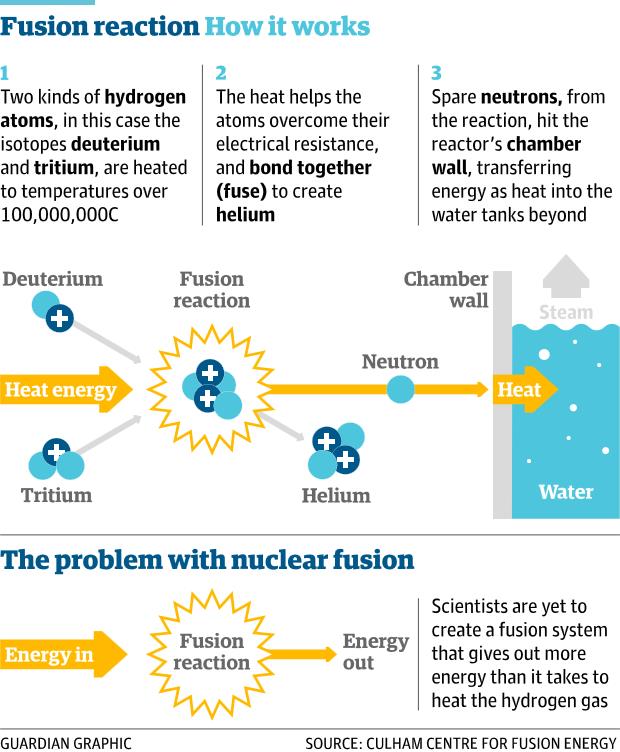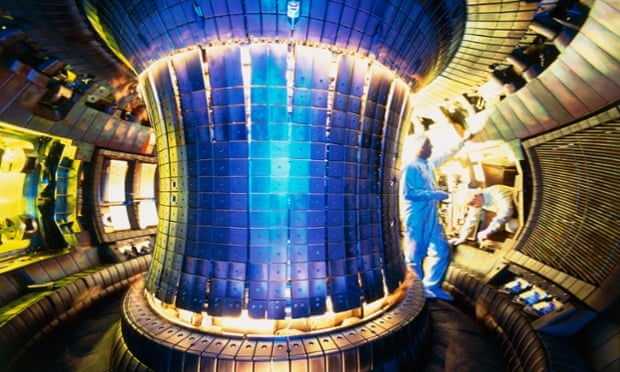Scientists have responded with scepticism to the announcement of a breakthrough in nuclear fusion by Lockheed Martin.
The arms manufacturer announced on Wednesday that it was “working on a new compact fusion reactor (CFR) that can be developed and deployed in as little as 10 years”. But Lockheed’s four paragraph press release and accompanying video are heavy on hyperbole and light on detail.
Project leader Tom McGuire, whose company is the Pentagon’s largest supplier of armaments, says the project could usher in a new era of peace and energy security.
“As a defence company our increasing mission is to enhance global security and this is how we do that in the energy realm,” says McGuire. “The old promise of atoms for peace was a noble one, but ultimately flawed because the technology wasn’t right for it. We can achieve that grand vision and bring clean power to the world. The true atomic age can start.”
But fusion researchers have responded coolly to the Lockheed announcement.
Professor Steven Cowley, director of the Culham Centre for Fusion Energy in Oxfordshire, says he is “nonplussed”. According to Cowley, Lockheed had said “all the usual things about how it’s going to save the world and how nice it would be if [the reactor] was small” but failed to produce any details upon which their success can be judged.
According to Lockheed, the key difference between this project and the glacially slow fusion projects in the UK and France is size.
It has changed the shape of the fusion reactor (called a tokamak) allowing them to create a plant that will fit on the back of a truck (or inside a battleship, as Lockheed told Reuters). The compact nature of their design scales everything down, including the development time. McGuire expects the project will see military deployment in a decade and domestic fusion power within 20 years.
Cowley says it is unlikely fusion will become part of the world’s power generation before 2050 and Lockheed’s announcement does little to change his mind. “I can’t see any results. I mean what have they achieved? It’s all promise,” says Cowley. “The proof is in the pudding in science. I’m surprised that a company like this would make this kind of announcement without announcing any results.”
One of the top scientists at the International Thermonuclear Experimental Reactor (Iter) told the Guardian: “Let’s just say that since they don’t provide any technical details of what their ‘breakthrough’ actually involves, I am very sceptical. It’s amazing how much publicity you can generate with minimal information.”
It appears that this is because the reactor in question has not been built and tested yet. “Some key parts of the prototype are theoretical and not yet proven,” Nathan Gilliland, CEO of General Fusion who are working on their own fusion reactor, told Wired.
The Lockheed website is unclear what stage of testing or construction the project has reached, although there are lots of photos of scientists standing next to complicated machinery. McGuire admits the concept is in its infancy. “That’s what we’re doing here, testing that concept out, to see if it really holds the promise that it appears to.”
Cowley says the success of fusion relies on two key pieces of information, which are absent from the Lockheed publicity.
Firstly the temperature within the tokamak must be hot enough to begin fusion, in excess of one hundred million degrees Celsius. Second the confinement time, which measures how long the reactor can contain the heat of the reaction before it escapes, must be long enough to create a self-sustaining reaction. Cowley says a successful fusion plant will have a confinement time of around three seconds. The record for the longest confinement time is around one second, held by the Joint European Torus (Jet) reactor at Culham.

Cowley says smaller units, such as the one being touted by Lockheed, were popular during the 1950s, 60s and 70s. But the maximum confinement time they could achieve was around 1 millisecond. Cowley says if the Lockheed team had produced temperatures in the range of 23-30 million C with a confinement time of 1/10 of a second, “that would be interesting”. Lockheed did not respond to a Guardian enquiry asking them to expand on the details of the project.
Fusion power has long been the sun that never rises. As the Guardian’s Leo Hickman observed in 2011, it is “perpetually 30 years away”.
Paradoxically, breakthroughs are announced with monotonous regularity. The hysteria that accompanies every false dawn is a reflection of the hope invested in fusion. It is seen as the silver bullet for the world’s troubled energy system and climate change – a zero-carbon, non-polluting energy source that uses elements mined from seawater.
— Peter Gleick (@PeterGleick) October 15, 2014Just a quick reminder for those who think this "fusion breakthrough" is new. #notholdingmybreath pic.twitter.com/wgLop8Y1hn
The technology recreates the fusion reaction that occurs in stars, where hydrogen nuclei bond together to create helium.
Fusion reactions are one million times more powerful than a chemical reaction like burning coal or oil. But to create conditions similar to the core of the sun, you need to heat things up, a lot. Getting the gases to the correct temperatures takes a lot of energy.
The difficulty for scientists and engineers is creating a system that gives out more energy than it consumes. The best effort so far was in the Jet reactor, where for two seconds an output of 16MW was created from an input of 25MW. Cowley says his team will try to break this record in 2017, but a positive balance is a long way away.
Traditional wisdom dictates that fusion reactors must be built on a large scale. In the case of Iter’s massive multinational venture in France the reactor will be 30 metres tall and weigh 23,000 tonnes. This is the typical solution to the problem of confinement time. Essentially, the larger the reactor, the more time it takes energy to escape and the more efficient the reaction becomes. But the massive scale means massive expense and slow progress – a problem that Lockheed say CFR will solve.
Dr Joel Gilmore, an energy market analyst from ROAM Consulting, says the Lockheed announcement is unlikely to raise any heartbeats in a sector that has grown used to overegged fusion announcements.
“Certainly, I’d welcome fusion as part of the world’s energy mix, but this announcement is a long way from a working prototype, let alone a commercially viable power generator. Fusion requires incredibly high temperatures and pressures, which is challenging, and a lot of people have been working on fusion for a long time. So I won’t get too excited yet.”
Perhaps the key insight to the Lockheed announcement is the fourth and final paragraph of its sparse press release.
Lockheed use their parting shot to advertise their size and profitability to potential investors in CFR. In the slick promotional video, McGuire describes fusion as “a high risk, high payoff endeavour”. Lockheed have come up with an idea and they want someone to give them some money so they can develop it.
Investment in fusion is exciting and potentially world-changing. But real breakthroughs occur when experiments actually take place.


